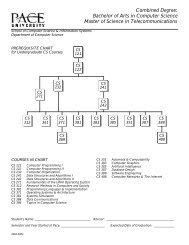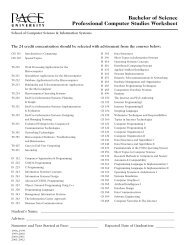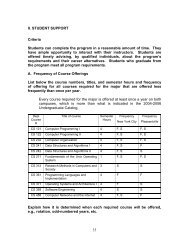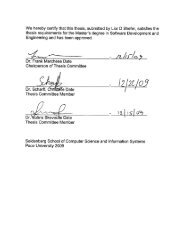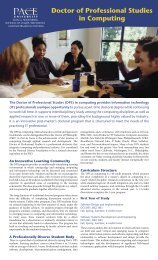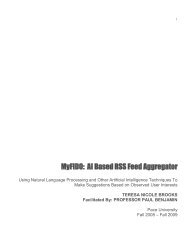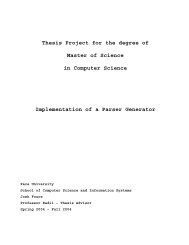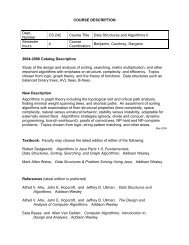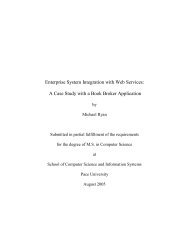I. OBJECTIVES, OUTCOMES and ASSESSMENT A ... - pace university
I. OBJECTIVES, OUTCOMES and ASSESSMENT A ... - pace university
I. OBJECTIVES, OUTCOMES and ASSESSMENT A ... - pace university
Create successful ePaper yourself
Turn your PDF publications into a flip-book with our unique Google optimized e-Paper software.
B.1.A.8. Indicate how your student outcomes map to your program<br />
objectives.<br />
As a matter of terminology, "program learning outcomes" <strong>and</strong> "student learning<br />
outcomes" refer to the same 11 statements. The key word is outcomes. (These<br />
same statements constitute our program's "student attributes" which are the<br />
focus of B.1.B.)<br />
Table 1.8<br />
How Program Objectives Are Supported by Student Learning Outcomes<br />
(Table extends to the following page.)<br />
Program's Educational Objectives Supporting Learning Outcomes<br />
Be equipped for responsible <strong>and</strong><br />
ethical participation <strong>and</strong> leadership<br />
roles as computing professionals<br />
<strong>and</strong><br />
Be equipped for lifelong learning<br />
Underst<strong>and</strong> the foundational ideas in<br />
computer science <strong>and</strong> be able to use<br />
this knowledge for guidance in<br />
technical problem-solving<br />
Be effective in the design <strong>and</strong><br />
construction of software applications<br />
d) An ability to function effectively on teams to<br />
accomplish a common goal<br />
e) An underst<strong>and</strong>ing of professional, ethical <strong>and</strong> social<br />
responsibilities.<br />
f) An ability to communicate effectively with a range of<br />
audiences.<br />
h) Recognition of the need for, <strong>and</strong> an ability to engage<br />
in, continuing professional development.<br />
a) An ability to apply knowledge of computing <strong>and</strong><br />
mathematics appropriate to the discipline.<br />
b) An ability to analyze a problem <strong>and</strong> to identify <strong>and</strong><br />
define the computing requirements appropriate to its<br />
solution.<br />
a) An ability to apply knowledge of computing <strong>and</strong><br />
mathematics appropriate to the discipline.<br />
b) An ability to analyze a problem <strong>and</strong> to identify <strong>and</strong><br />
define the computing requirements appropriate to its<br />
solution.<br />
c) An ability to design, implement <strong>and</strong> evaluate a<br />
computer-based system, process, component, or<br />
program to meet desired needs.<br />
i) An ability to use current techniques, skills, <strong>and</strong> tools<br />
necessary for computing practices.<br />
j) An ability to apply mathematical foundations,<br />
algorithmic principles, <strong>and</strong> computer science theory in the<br />
modeling <strong>and</strong> design of computer-based systems in a wa<br />
that demonstrates comprehension of the tradeoffs<br />
involved in design choices.<br />
27



